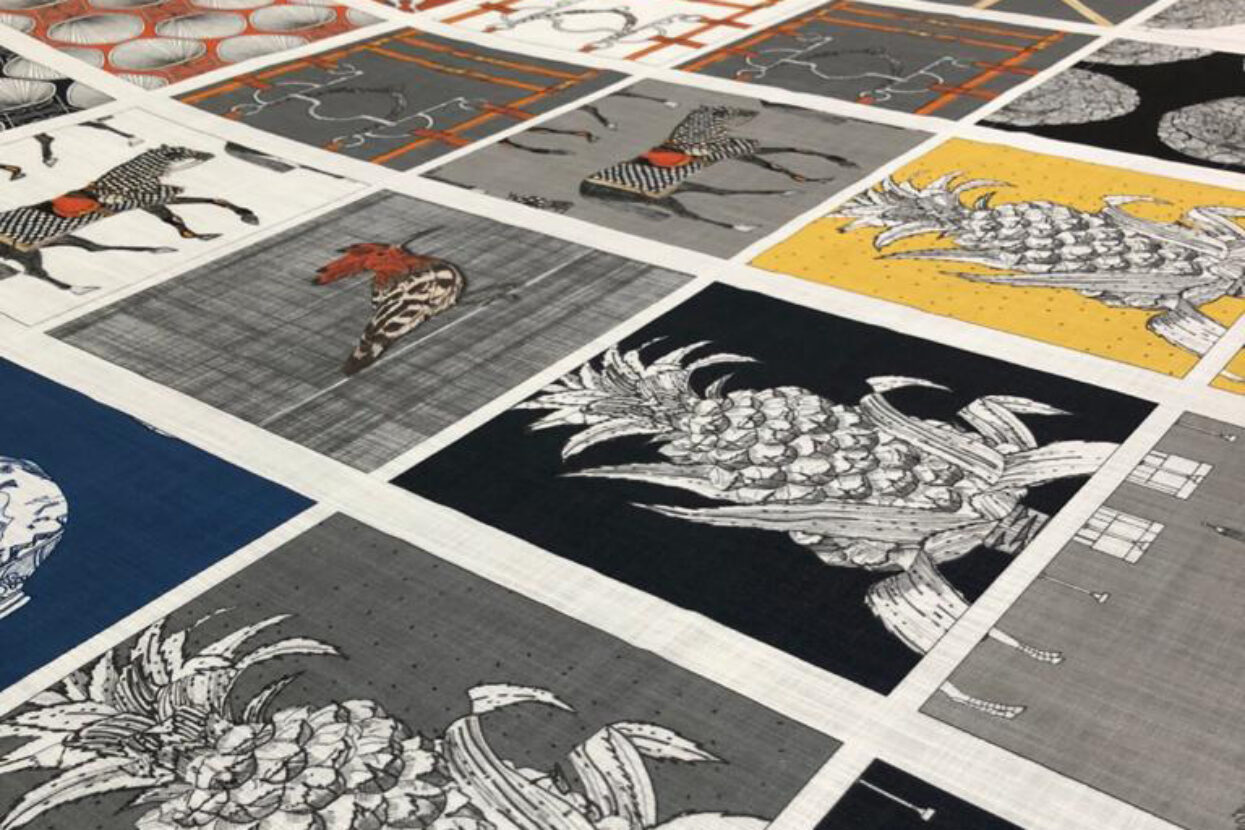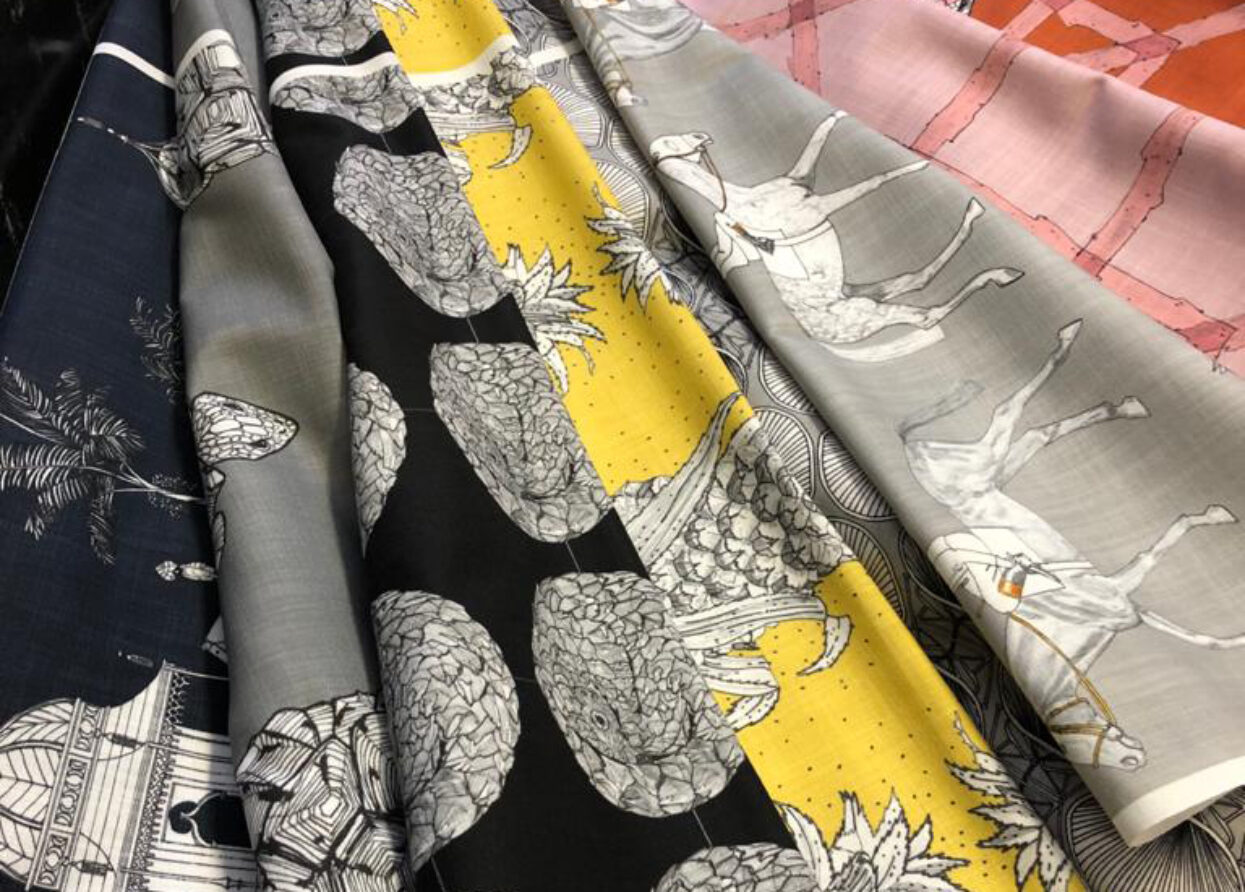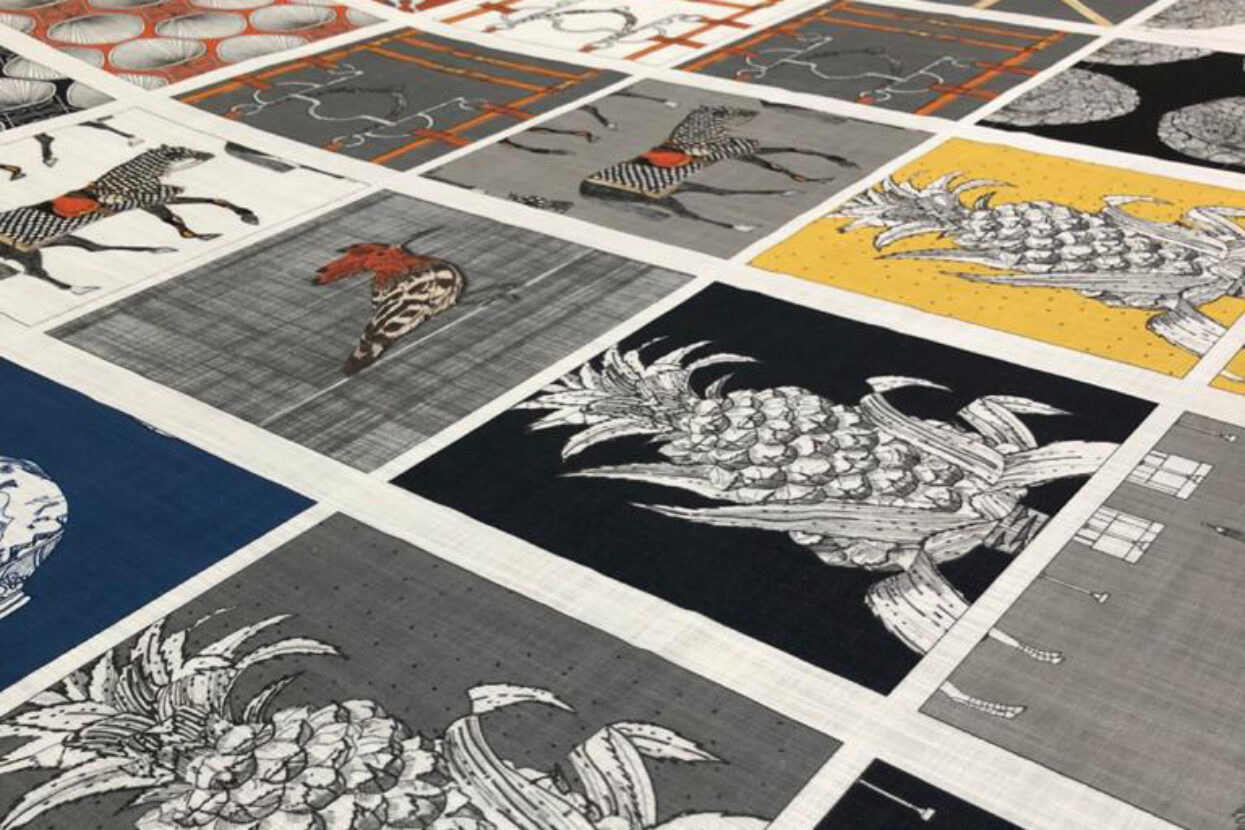As the digital textile marketplace expands worldwide it strategically fills the gaps where analogue industrial production was once the key player. The high-volume rotary production of the past has been replaced in some instances by hybrid supply or has ceased entirely to exist in its previous volume meterage. Digital textile technology now enables customised production at any volume.
Adapting to demand, Remo and the team at iMaterial based in Cape Town in South Africa saw a niche printing reduced rotary volume orders that traditional mills turned away. A discovery that has stood them in good stead. iMaterial are now the only textile printer in Cape Town offering small, medium and (reduced) volume production using both analogue and digital textile printing. Digital technology has democratised the textile sector and enabled the independent designer to build a business one small step at a time and grow to generate a global business.
In this interview we talk with Remo Gorlei founder of the family business iMaterial about their unique printing business and learn how their skills and expert knowledge of both analogue and digital textile printing has helped their customer Chapman Collection to create a designer brand serving the equestrian market.

Caption: As the digital textile marketplace expands worldwide it strategically fills the gaps where analogue industrial production was once the key player. Image credit: iMaterial – Sally Chapman.
Tell us about your business, when was it founded and what services do you provide?
“Imaterial was established in 1986 by founder members Remo Gorlei & Marcia Gorlei. The Company has grown exponentially over the years both in the services we supply and the staff we employ. We aim to supply a textile print service for exclusive custom designs onto natural fabrics. We include print techniques using automatic rotary printing, hand screen printing & digital roll to roll printing. We specialise in seamless pattern printing for the fashion & home decor industries. Added to the printing service we also offer pre-treatment & post-treatment together with our own inhouse fabric coatings. We are a vertical plant from design studio, screen engraving, colour mixing, printing and fabric finishing.”
How has the Textile market in South Africa evolved over the last 10 years?
“Unfortunately, the Textile market in South Africa has shrunk and many good big textile mills have closed. We had many state-of-the-art textile companies, with great machinery all imported from Europe, but these factories have all disappeared. This has to do with cheap imports, price squeeze and complicated labour laws in SA. Furthermore, with our volatile currency it has become difficult to have consistency when importing stock, inks, print auxiliaries, spare parts and new machinery. Going back 15-20 years the textile industry in Cape Town was the biggest employee of any industry. Since then, many jobs have been lost as the big CMT factories mostly closed. For us now, we remain the last of the rotary screen-printing factories in Cape Town but have also managed to grow our Digital Department to cater for more specific design and orders.”

Caption: “As we have analogue and digital, we can produce small, medium or large runs. We do not rely on any single customer but rather have a large and variety filled customer base.” Image Credit: iMaterial – Sally Chapman.
How many meters are printed each year across analogue digital and has that volume grown or reduced?
“Being a niche market and supplying the fashion and interior industry there is always something happening. Digital production has definitely grown for us, especially since purchasing our second MS industrial digital machine. The big orders for rotary are few and far between”.
As a business built on analogue technologies when did you begin the journey towards digital and why?
“When we started analogue, we decided to cut on minimum runs that the bigger mills where doing. Going back 15-20 years the minimum rotary order was 1000m (500m per colourway). We started offering a service for smaller runs that the big mills did not take. After some years we built up a good reputation and many smaller customers were contacting us. Analogue printing has limitations, such as the number of colours, complex designs, repeat size etc. We found that we were turning a lot of business away.
This was when we started investigating digital printing. We already had the customer base and reputation, all we had to do was to educate our clients on the advantages of digital. So, in 2006 we bought our first of two DuPont digital machines. Digital machine mechanics operate similar to rotary machines. The fabric infeed, belt carrier and fabric exit are a similar design to a rotary machine. Really the only difference is that you are replacing the screen heads with digital heads. If you have rotary machines, then the transformation to digital is much easier.”
Do you also use digital for bulk production?
“Initially with our two DuPont Digital machines we could not do bulk. The machine technology in the early 2000’s could not handle large runs. After 2010 digital textile technology became way more advanced. We waited until this new technology was tried and proven. In 2016 and then again in 2018 we purchased bulk printing digital machines.”
What are the challenges when working remotely and directly with designers and how do you overcome them?
“Either or, it is very simple with today’s social media to communicate with clients. The trick is in the experience, knowing which questions to ask the customers and understanding their needs. We are fortunate in that we have employees who come from analogue background who have been trained in digital. Having an understanding of both techniques has big advantages. Customers can be sent in the right direction from the word go – be it digital printing or analogue printing that they may require.”
How important is sustainability within the South African marketplace and are customers becoming more aware of sustainable certification?
“It is very important. South Africa has a tendency to follow in European footsteps, albeit a couple of years behind. Clients love the idea that we use water-pigments and natural fabrics. This will keep evolving as our own customers grow their eco- friendly textile ranges. This has also become a selling point for many of our customers who come to us seeking eco efficient textiles.

Caption: “Our customers have bought into printing only what is needed, print on demand. They know that they can top up their good selling orders easily and efficiently with us.” Image Credit: Credit: iMaterial – Sally Chapman.
Have you seen a growth in close proximity production during the pandemic and if so, do you think the switch will be permanent?
“Cape Town is a very diverse City. It is the design Capital of South Africa with many attractions. It has the finest restaurants, hotels, coffee shops, beaches, wine farms, markets and the most amazing waterfront. There is a huge push towards supporting local since the pandemic. With our ability to produce unique and exclusive textiles, most of our customers come from close proximity, so we have managed to ride out the pandemic.”
What’s your vision for the future, do you see an increase in the requirement for digital printing within the South African marketplace and if so, how do you plan to expand?
“At the moment our printing machines can handle bulk and with our experienced operations team we are fulfilling our orders. However, we are always looking at improving and we are busy researching some interesting machinery additions. This may ultimately depend on finding a financial backer, but expansion would be beautiful for us.”
Working closely with clients Remo and the team take great care to pass on their knowledge to ensure that new entrants to the print market can also flourish. One such example is the designer Sally Chapman who turned to iMaterial to help her manufacture her printed designs for her equestrian textile brand “The Chapman Collection”.
Sally kindly explains her digital journey and how she sought to work with an established and highly knowledgeable team:
“Chapman Collection was launched in 2017 at 100% Design – part of Decorex South Africa. At that stage I was only manufacturing wallpaper but a week before the exhibition my supplier let me down. This made me think and I decided to have some of my designs digitally printed onto fabric to compliment my collection. The wallpaper samples were collected on the way to the airport the day before the exhibition. This made me realise that I should be in fabric which had proved more successful.
I researched various South African printing companies finally deciding on Imaterial. They have the world’s latest textile machinery and have by far the most experience. Being new to the fabric business I initially went the rotary route with a few of my designs. On sampling I realised that digital was easier, quicker and far more versatile.
At Imaterial I am able to work closely with the digital machine operator when needed and this way am able to downsize designs, change colours and make sure there is no waste. Imaterial has taught me so much about the digital side of printing, their experience is priceless. I have also got to know many of Imaterial’s employers who have helped me get to know the process. Remo (owner) has guided me throughout. As a novice in the industry this has proved invaluable. They are based in Cape Town where my studio is, so I am able to work closely with them when needed.
The Chapman Collection has an international client base mainly in the equestrian world. I supply retail stores, interior decorators, on line stores and the public. Over the past three years I have found my niche in the Equine market. There are very few fabrics in this field. All my designs are hand drawn so have a unique feel to them. Pelham Bit and Horse Rug are my bestselling patterns. Classic simple designs. Chapman Collection is a unique small brand which is slowly being recognised internationally.
Social media has played a big part in our growth, Instagram @chapman_collection has been my source for getting known.
As a prolific designer I come up with new designs constantly. Furthermore, I have an archive of sketches and drawings dating back 20 years. These can be easily scanned and turned into seamless print textiles.
Digital printing technology has allowed me to increase my design collection without huge overheads as well as changing colours and pattern size instantly. If the design doesn’t prove successful it can be dropped without much cost. As my bestselling items are cushion covers, I am able to print every order individually, despite size, pattern or colour. Orders can combine cushion covers, meters of fabrics as well as lamp shades all in the same print run.
On demand printing has allowed me to reach a far bigger customer base as I am able to process their individual orders without having to keep a huge amount of stock. My customers are happy to wait a few weeks for their orders getting exactly what they want as opposed to buying mass produced products. With no need for stock or for warehousing.
The availability of on demand print has allowed me to work closely with customers creating what they want with the perimeters of my designs. Clients have had their own racing colours added to the jockey’s silks in designs of mine. Bespoke work is also a lot easier as I will draw up a design and am able to print a sample instantly for approval.
An added advantage is the eco water pigment printing that Imaterial specialise in. All my textiles are printed onto natural fabrics ensuring that my collection remain on course for a greener, safer future”. Sally Chapman (owner) – Cape Town, South Africa.
Digital technologies continue to advance through the landscape of rotary production, and it would seem that a new hybrid platform has evolved. Whether a digital or analogue output, the market must meet demand and as Remo and the team at iMaterial have demonstrated – agility is a key factor.
As we move into the next decade with a 230% increase in digital textile production by 2025 as predicted by Allied Market Research, one thing is for sure, Textiles have always been a complicated marketplace and a sector where digital technology increasingly imparts commercial dexterity. For Remo’s business – iMaterial – digital machinery has been utilised to make sure that no order is ever turned away and in doing so has also ensured that his family business has survived and continues to thrive.